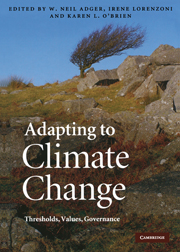Book contents
- Frontmatter
- Contents
- List of contributors
- Preface
- 1 Adaptation now
- Part I Adapting to thresholds in physical and ecological systems
- Part II The role of values and culture in adaptation
- Part III Governance, knowledge and technologies for adaptation
- 20 Whether our levers are long enough and the fulcrum strong? Exploring the soft underbelly of adaptation decisions and actions
- 21 Decentralized planning and climate adaptation: toward transparent governance
- 22 Climate adaptation, local institutions and rural livelihoods
- 23 Adaptive governance for a changing coastline: science, policy and publics in search of a sustainable future
- 24 Climate change, international cooperation and adaptation in transboundary water management
- 25 Decentralization: a window of opportunity for successful adaptation to climate change?
- 26 Adapting to climate change in Sámi reindeer herding: the nation-state as problem and solution
- 27 Limits to adaptation: analysing institutional constraints
- 28 Accessing diversification, networks and traditional resource management as adaptations to climate extremes
- 29 Governance limits to effective global financial support for adaptation
- 30 Organizational learning and governance in adaptation in urban development
- 31 Conclusions: Transforming the world
- Index
- References
24 - Climate change, international cooperation and adaptation in transboundary water management
Published online by Cambridge University Press: 31 August 2009
- Frontmatter
- Contents
- List of contributors
- Preface
- 1 Adaptation now
- Part I Adapting to thresholds in physical and ecological systems
- Part II The role of values and culture in adaptation
- Part III Governance, knowledge and technologies for adaptation
- 20 Whether our levers are long enough and the fulcrum strong? Exploring the soft underbelly of adaptation decisions and actions
- 21 Decentralized planning and climate adaptation: toward transparent governance
- 22 Climate adaptation, local institutions and rural livelihoods
- 23 Adaptive governance for a changing coastline: science, policy and publics in search of a sustainable future
- 24 Climate change, international cooperation and adaptation in transboundary water management
- 25 Decentralization: a window of opportunity for successful adaptation to climate change?
- 26 Adapting to climate change in Sámi reindeer herding: the nation-state as problem and solution
- 27 Limits to adaptation: analysing institutional constraints
- 28 Accessing diversification, networks and traditional resource management as adaptations to climate extremes
- 29 Governance limits to effective global financial support for adaptation
- 30 Organizational learning and governance in adaptation in urban development
- 31 Conclusions: Transforming the world
- Index
- References
Summary
Introduction
The recently published report of the Intergovernmental Panel on Climate Change (IPCC, 2007) suggests clear evidence of climate change impacts. Global average air and ocean temperatures are rising. As a result, snow and ice are melting, leading to a rise in sea levels. Extreme weather events and hazards, such as flooding, heat waves and cyclones, are becoming more frequent, and the geographical and temporal clustering of precipitation patterns is shifting. In short, our hydrologic and ecological systems are changing. While an extensive body of literature has already developed around the question of international cooperation as a necessary prerequisite for mitigating climate change (Dunn and Falvin, 2002; Haas, 2004; Caney, 2005), other research indicates that some of its effects are already irreversible (IPCC, 2007). Thus scholars are also increasingly examining the possible role of international cooperation in the adaptation to climate change impacts.
There are at least three distinct roles for international cooperation in climate change mitigation and adaptation, which differ from each other in terms of their global communitarian basis. First, international cooperation can lead to positive-sum outcomes for the particular states involved. For example, the pooling of resources for the provision of public goods such as data, information and know-how, if shared in a non-exclusive way, can produce positive externalities. Second, confidence-building measures between two or more states can help to avoid conflicts over the use of increasingly uncertain stocks and flows of some internationally shared resources.
- Type
- Chapter
- Information
- Adapting to Climate ChangeThresholds, Values, Governance, pp. 384 - 398Publisher: Cambridge University PressPrint publication year: 2009
References
- 4
- Cited by



